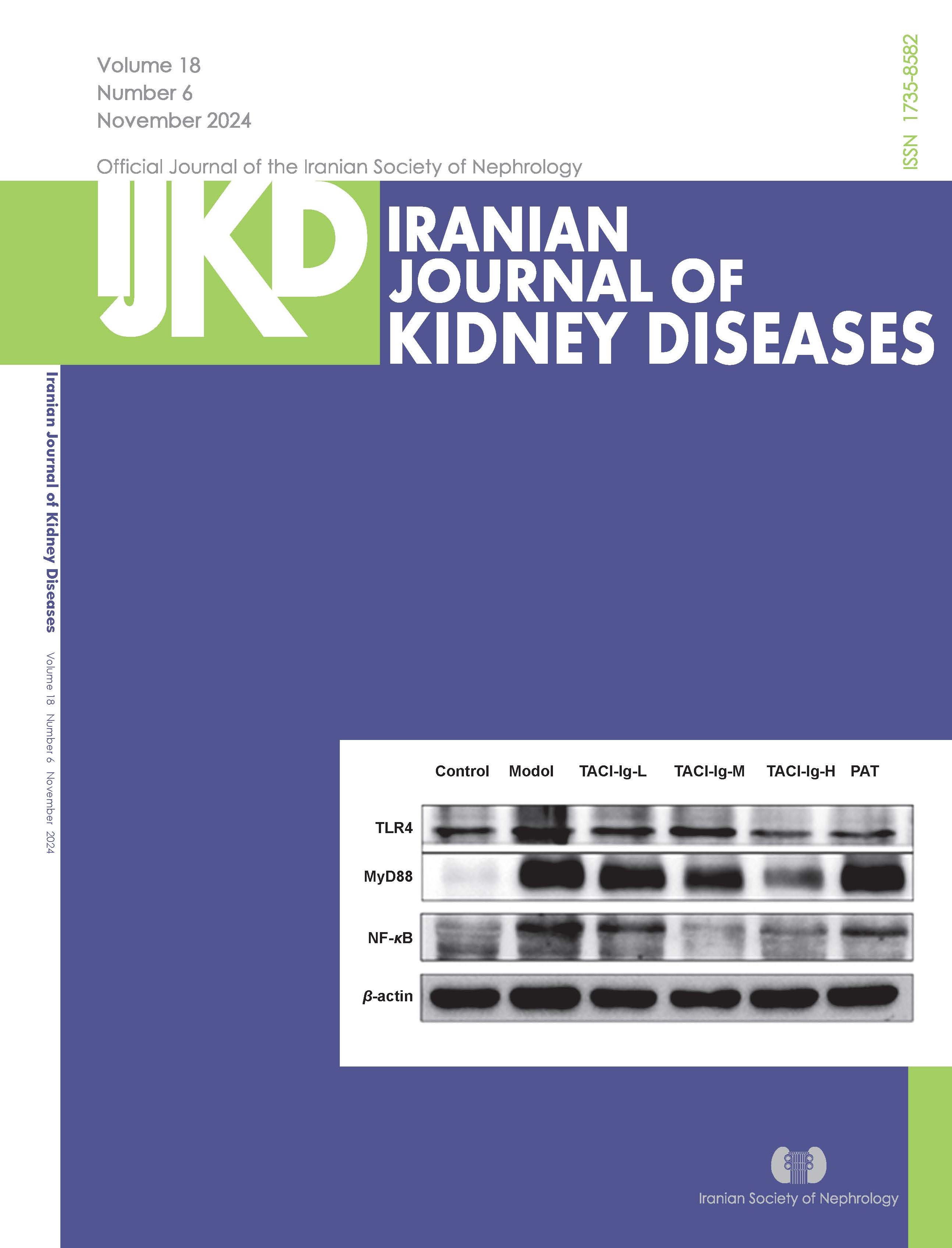TACI Ig Fusion Protein Inhibits TLR4/MyD88/NF-κB Pathway Alleviates Renal Injury in IgA Nephropathy Rats
DOI:
https://doi.org/10.52547/a63wam88Keywords:
TACI Fusion, Protein, IgA Nephropathy, Rats, Inflammatory DamageAbstract
Introduction. To evaluate the impact of TACI fusion protein (TACI-Ig) on IgA nephropathy (IgAN) in rats, and to explore its mechanism and relationship with TLR4/MyD88/NF-κB pathway. Method. Sprague Dawley(SD)rats were divided into six groups: control, model, TACI-Ig low dose (TACI-Ig-L), medium dose (TACI-Ig-M), high dose (TACI-Ig-H), and prednisone acetate (PAT) group. The control group and model group received physiological saline injections, while the TACI-Ig groups were administered doses of 7.18, 14.36, and 28.72 mg/kg of TACI-Ig, respectively. PAT group was pretreated with prednisone acetate. After 8 weeks, kidney weight/body weight ratios, 24-hour urine protein (24 h UP), serum creatinine (SCr), and blood urea nitrogen (BUN) levels were measured. Additionally, concentrations of B cell activating factor (BAFF), APRIL, and Gd-IgA1 were evaluated by using ELISA. Pathological changes in kidney tissues were scored, and TLR4, MyD88, NF-κB expression levels were detected through western blot (WB) and RT-qPCR.
Results. Renal function assessments showed that the IgAN model group exhibited increased in 24 h UP, SCr, BUN, and elevated serum levels of BAFF, APRIL, Gd-IgA1, alongside higher TLR4/MyD88/NF-κB protein expression. TACI-Ig treatment significantly reduced proteinuria, SCr, BUN, levels of BAFF, APRIL, and Gd-IgA1 in IgAN rats. Pathologically, TACI-Ig ameliorated glomerular mesangial deposition and fibrosis. It also inhibited TLR4/MyD88/NF-κB protein expression, demonstrating anti-inflammatory and immune regulatory effects.
Conclusions. TACI-Ig mitigates renal injury in IgAN rats by reducing inflammatory infiltration and IgA deposition and suppressing the pathway of TLR4/MyD88/NF-κB, offering data for developing effective treatments for IgAN.
Downloads
References
1. Schena FP. A retrospective analysis of the natural history of primary IgA nephropathy worldwide. Am J Med. 1990; 89(2): 209-215.
2. Berthoux FC , Mohey H, Afiani A. Natural history of primary IgA nephropathy. Semin Nephrol. 2008; 28(1): 4-9.
3. Cheung CK, Barratt J. The role of BAFF and APRIL in IgA nephropathy: pathogenic mechanisms and targeted therapies. Front Nephrol. 2024;1;3:1346769.
4. Moisini I, Davidson A. BAFF: a local and systemic target in autoimmune diseases. Clin Exp Immunol. 2009; 158(2):
155-163.
5. McAllister E , Jellusova J. BAFF signaling in B cell metabolism. Curr Opin Immunol. 2021; 71: 69-74.
6. Shabgah AG, Shariati-Sarabi Z, Tavakkol-Afshari J, et al.The role of BAFF and APRIL in rheumatoid arthritis. J Cell Physiol. 2019; 234(10): 17050-17063.
7. Wong DP, Roy NK, Zhang K, et al. A BAFF ligand-based CAR-T cell targeting three receptors and multiple B cell cancers. Nat Commun. 2022; 13(1): 217.
8. Kalled SL. The role of BAFF in immune function and implications for autoimmunity. Immunol Rev. 2005; 204:
43-54.
9. Zhang H, Sun SC. NF-kappaB in inflammation and renal diseases. Cell Biosci. 2015; 5: 63.
10. Dechkajorn W, Benjathummarak S, Kumsiri R, et al. The role of the BAFF/APRIL system in the T cell-independent specific response to blood stage Plasmodium falciparum hemozoin. Cytokine. 2018; 111: 445-453.
11. Yeo SC, Cheung CK, Barratt J. New insights into the pathogenesis of IgA nephropathy. Pediatr Nephrol. 2018;
33(5): 763-777.
12. Lee M, Suzuki H, Ogiwara K, et al. The nucleotide-sensing Toll-Like Receptor 9/Toll-Like Receptor 7 system is a potential therapeutic target for IgA nephropathy. Kidney Int. 2023; 104(5): 943-955.
13. He H, Shen M , Tang Y, et al. LPS/TLR4 Pathway regulates IgA1 Secretion to Induce IgA Nephropathy. Altern Ther Health M. 2024; 30(1): 419-425.
14. Dhillon S. T elitacicept: First Approval. Drugs. 2021; 81(14):1671-1675.
15. Shi F, Xue R , Zhou X, et al. Telitacicept as a BLyS/APRIL dual inhibitor for autoimmune disease. Immunopharm Immunot. 2021; 43(6): 666-673.
16. Zhang L, Jin H, Wang D, et al. Case report: Successful treatment of refractory membranous nephropathy with telitacicept. Front Immunol. 2023; 14: 1268929.
17. Barratt J, L afayette RA, Zhang H, et al. IgA nephropathy: the lectin pathway and implications for targeted therapy. Kidney Int. 2023; 104(2): 254-264.
18. Pattrapornpi sut P, Avila-Casado C, Reich HN. IgA Nephropathy: Core Curriculum 2021. Am J Kidney Dis. 2021; 78(3): 429-441.
19. Tang Y, Xiao Y, He H, et al. Aberrant Gut Microbiome Contributes to Barrier Dysfunction, Inflammation, and Local Immune Responses in IgA Nephropathy. kidney Blood Press R. 2023; 48(1): 261-276.
20. Gross JA, Di llon SR, Mudri S, et al. TACI-Ig neutralizes molecules critical for B cell development and autoimmune disease. impaired B cell maturation in mice lacking BLyS. Immunity. 2001; 15(2): 289-302.
21. Prieto-Pena D, Genre F, Remuzgo-Martinez S, et al. BAFF, APRIL and BAFFR on the pathogenesis of Immunoglobulin-A vasculitis. Sci Rep-Uk. 2021; 11(1): 11510.
22. Yeo SC, Barr att J. The contribution of a proliferationinducing ligand (APRIL) and other TNF superfamily members in pathogenesis and progression of IgA nephropathy. Clin Kidney J. 2023; 16(Suppl 2): ii9-ii18.
23. Mockel T, Ba sta F, Weinmann-Menke J, et al. B cell activating factor (BAFF): Structure, functions, autoimmunity and clinical implications in Systemic Lupus Erythematosus (SLE). Autoimmun Rev. 2021; 20(2): 102736.
24. Mathur M, Ba rratt J, Chacko B, et al. A Phase 2 Trial of Sibeprenlimab in Patients with IgA Nephropathy. New Engl J Med. 2024; 390(1): 20-31.
25. Cai J, Gao D , Liu D, et al. Telitacicept for autoimmune nephropathy. Front Immunol. 2023; 14: 1169084.
26. Abdel-Aziz A M, Fathy EM, et al.TLR4/MyD88/NF-κB signaling pathway involved in the protective effect of diacerein against lung fibrosis in rats. Hum Exp Toxicol. 2023; 42:9603271231200213.
27. Tang Y, Sun W, He H, et al. Activation of intestinal mucosal TLR4/NF-kappaB pathway is associated with renal damage in mice with pseudo-sterile IgA nephropathy. Xi Bao Yu Fen Zi Mian Yi Xue Za Zhi. 2023; 39(10): 865-871.
28. Nihei Y, Suzu ki H, Suzuki Y. Current understanding of IgA antibodies in the pathogenesis of IgA nephropathy. Front Immunol. 2023; 14: 1165394.


